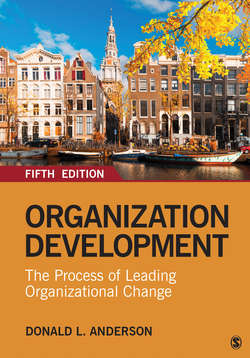Читать книгу Organization Development - Donald L. Anderson - Страница 8
На сайте Литреса книга снята с продажи.
ОглавлениеPreface
In 2018, the World Economic Forum issued its Future of Jobs Report. Perhaps not surprisingly, the report noted an increase in jobs focused on robotics and automation, Big Data, artificial intelligence, and data science, whereas it also noted that jobs focused on data entry and factory work will likely be in decline. The report authors predicted that more than half of all jobs will require significant reskilling by 2022, making lifelong learning an increasing necessity. Yet against the backdrop of this focus on technology, the report authors also made a specific mention of the increasing influence of the field of organization development (OD). The report concluded:
Also expected to grow are roles that leverage distinctively “human” skills, such as . . . Training and Development, People and Culture, and Organizational Development Specialists (World Economic Forum, 2018, p. viii).
It seems that every few years, the field of organization development (OD) finds itself at a crossroads. Some feel that the field has strayed too far from its founding humanistic values of democracy, diversity, autonomy, collaboration, and choice. They argue that OD is in danger of being diluted or collapsed into human resources roles, leadership development, and talent management. Others feel that the “touchy feely” old values deserve a fresh update and that OD practitioners have a great deal to contribute to organizational efficiency, effectiveness, and enhanced performance in ways that helps both organization and individual. They see the role of the practitioner as a business adviser who can incorporate humanistic values without being hypocritical.
I wrote (and continue to update) this book because, like the World Economic Forum, I firmly believe that OD as a field of research and practice has much to offer to people in contemporary organizations who are struggling with an incredible amount of change. Old management styles no longer fit the needs of today’s workplace and workers. New organizational forms are emerging to cope with the increasing pace of change, globalization, digitization and the latest technologies, economic pressures, and the expectations of the contemporary workforce. Managers struggle to engage employees despite ever-present threats of downsizing and outsourcing. In such an environment, many employees find work to be less personally satisfying than they did before.
Skilled OD practitioners understand the dynamics of human systems and can intervene to encourage a healthy, engaging, and productive environment. Unfortunately, it has been challenging for many students to develop these skills. It generally requires “breaking in” to an OD department, finding a (hopefully skilled) mentor, and learning as much as possible through academic courses or self-discovery. While they are regularly tested on the job, managers and executives have few opportunities to develop their skills as change agents as well. Project managers, IT professionals, educators, and health care administrators all report that the skills of OD are applicable to their jobs.
My hope is that this book will provide theoretical and practical background in OD to give you an introduction to the basic processes of organization development and change. It will also give you a chance to practice in a safe environment where you can develop your skills. I hope you find the book to be readable but rigorous—practical and relevant but with a solid academic foundation—and comprehensive enough without being exhausting.
For this fifth edition, I have updated many sections of the book to reflect recent research and advances in practice while retaining classic approaches and foundational theories with which most practitioners ought to be familiar. Highlights of this new edition include the following:
A new feature, “Profiles in Organization Development,” that showcases practitioners and researchers to highlight their experience, different paths to and histories in the field, and the diverse types of OD that are practiced today
Additional case studies to allow you to practice using OD concepts and skills
A revision to Chapters 12 and 13 to highlight the growing importance of organization design and culture interventions
Additional examples of global issues in organization development
New readings at the end of each chapter, where appropriate
My continued thanks to the students at the University of Denver as well as to the clients who share with me their struggles in achieving change at work. Reviewers and readers of prior editions continued to share ideas to improve this volume. As always, I am grateful to my family and friends, especially my wife, Jennifer, for their patience, support, and encouragement.
Exercises and Activities
Many chapters contain exercises, activities, and role plays that can be used to practice skills and apply concepts developed in several chapters of the book. This chart details which exercises and activities accompany which chapter and topic.
Ancillaries
Instructor Teaching Site
A password-protected instructor’s manual is available at edge.sagepub.com/andersonod5e to help instructors plan and teach their courses. These resources have been designed to help instructors make the classes as practical and interesting as possible for students.
An Overview for the Instructor offers the author’s insights on how to most effectively use this book in a course on organization development and change.
PowerPoint Slides capture key concepts and terms for each chapter for use in lectures and review.
Case Epilogues provide additional information about the organizations or scenarios featured in the text.
Discussion Questions suggest additional topics to engage students during classroom discussions and activities.
Sample Course Syllabi provide models for structuring your course.
A Test Bank includes multiple-choice, short-answer, and essay exam questions for each chapter.
Video Resources for each chapter help launch class discussion.
This text is accompanied by Cases and Exercises in Organization Development & Change, Second Edition (ISBN 978–1-5063–4447–8), which follows the same chapter organization as this text. A bundle of this text with the cases and exercises book is also available.
